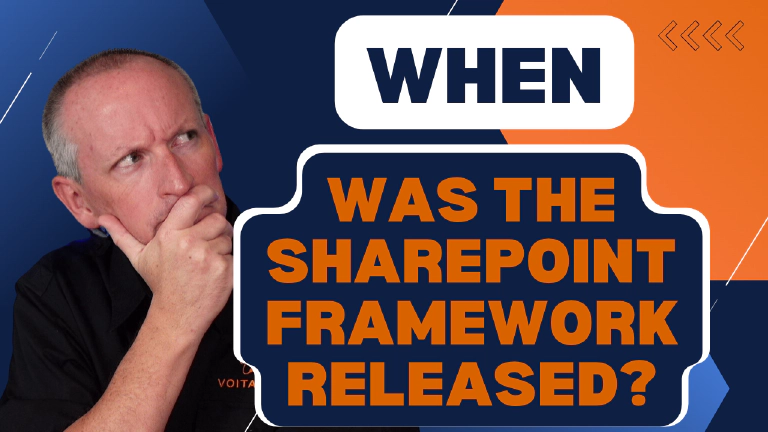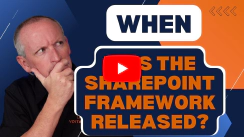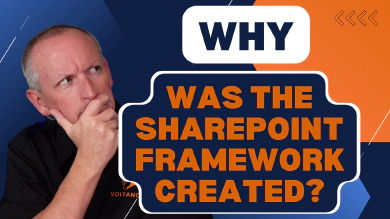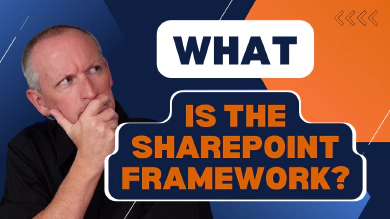This is one of a multi-part series of posts answering the most common questions on the SharePoint Framework. This series, SharePoint Framework Five “W"s & One “H” answered, gives you the best high-level picture of the SharePoint Framework. I ( Andrew Connell) wrote this series in late 2020 to help people new to the SharePoint Framework get the answers to the most common and basic questions about the SharePoint Framework.

In this post, I want to answer the question of when Microsoft released the SharePoint Framework (SPFx). But I don’t just want to tackle the question of when it was initially released, rather let’s look at some of the major milestones in the history of the SPFx.
SPFx Introduced May 2016
Microsoft first introduced their plans for the SPFx at their virtual Future of SharePoint event in May 2016. All we learned was the motivation and some high-level marketing with a pre-recorded demo creating a solution. It wasn’t until a few weeks later when the first developer preview was released to developers to start playing with.
After Microsoft shipped multiple developer preview and release candidates throughout the remainder of 2016…
SPFx v1.0 released February 2017
In February 2017, Microsoft released the first production version of the SPFx to developers. This first version was only available in SharePoint Online and included the most basic parts of SPFx.
The v1 release included the core SPFx runtime, developer & build toolchain, and the ability to create client-side web parts. The first release also required developers to deploy their projects in two parts: one part registered the SPFx component with SharePoint by deploying an .sppkg file to the SharePoint App Catalog to make SharePoint Online aware of the component.
The other part developers had to deploy were the files about their component. At a minimum, this included three files:
- A manifest file that pointed to the other files that made up the component. This file was referenced by the files deployed to SharePoint in the .sppkg file.
- JavaScript bundle that represented the SPFx component (client-side web part)
- JavaScript file for all localized strings in the default SPFx language (US English)
SPFx v1.3.1 introduces SPFx extensions summer 2017
Later in the summer of 2017, Microsoft quickly expanded the feature set to include extensions in SPFx v1.3.1. SPFx extensions were introduced to enable common SharePoint user experience customizations that were only possible in classic sites to SharePoint modern sites.
You can learn more about extensions from the first post in this series: What is the SharePoint Framework | What can you build with the SharePoint Framework? | Extensions.
Late 2017: SharePoint Server 2016 gets the SPFx v1.1
There were two major milestones for the SPFx in late 2017. The first of which didn’t involve an update to the SPFx, rather it was an update to SharePoint Server. Microsoft added support for the SPFx to SharePoint Server 2016. This happened with the install of Feature Pack 2 for SharePoint Server 2016.
Different Versions of SPFx and SharePoint Online & SharePoint Server 2016 FP2
It’s worth noting that the version of SPFx in SharePoint Server 2016 and SharePoint Online isn’t the same, nor will they ever be. This is due to two reasons.
First, on-premises installations of SharePoint Server always trail behind SharePoint Online due to the time it takes to test, package, validate, and distribute the on-premises versions of SharePoint compared to SharePoint Online.
The second reason is that some components in the SPFx will only work in a modern experience. This is the case with SPFx extensions; SPFx extensions will only work on a modern page. The modern experience was not added to SharePoint Server on-premises until SharePoint Server 2019.
SPFx v1.4.0 adds “includeClientSideAssets” to packages
The other significant milestone in late 2017 involved simplified deployments for SPFx solutions in SharePoint Online. Prior to SPFx 1.4.0, developers had to deploy two sets of resources for new and updated solutions. One set went to SharePoint to register the new components & the other set went to an external hosting location to serve up the component manifests and bundles.
Are you ready to learn the SharePoint Framework? Check out our on-demand video course with over 30 hours of demos, explanation and downloadable code: Mastering the SharePoint Framework!
Start with the FREE Starter bundle that includes three (3) chapters including a walk-through of setting up your developer environment to start creating SharePoint Framework components.
Once you start working, jump to the Fundamentals bundle to learn the basics and start creating SharePoint Framework components. The Ultimate bundle will make you a master at the SharePoint Framework with automated testing, continuous monitoring, implement CI/CD practices, and learn other advanced techniques.
The Ultimate bundle includes the Fundamentals bundle and grants you access to our live monthly office hours meetings as well as access to our student-only mastermind group.
In the SPFx v1.4.0 release, Microsoft introduced a new property, includeClientSideAssets, to SPFx solutions manifests. When this property is set to true, the SPFx build toolchain will include the component manifests and bundles in the resulting *.sppkg file. Then, upon deployment, these files are extracted and deployed to the tenant’s Office 365 CDN automatically. This improvement reduces the deployment steps from two to one in that developers no longer have to deploy the component’s resources to another location.
SPFx v1.4.1 introduces support for calling Entra ID secured endpoints, including Microsoft Graph
In early 2018, the SPFx v1.4.1 release added the ability to call Entra ID secured APIs from SPFx solutions. This release also included simplified support for calling Microsoft Graph in SPFx solutions.
Learn More About Calling Entra ID Secured APIs
You can learn more about how to call Microsoft Entra ID secured APIs and Microsoft Graph from the SPFx documentation
Learn how to leverage the SharePoint REST APIs, Microsoft Graph, and both anonymous, as well as Entra ID, secured third-party endpoints in my course, Mastering the SharePoint Framework. All three topics are covered in the Fundamentals bundle.
SharePoint Server 2019 includes support for SPFx v1.4.1
When Microsoft released SharePoint Server 2019 in September 2018, they included support for SPFx v1.4.1.
SPFx v1.11.0 includes support for the Microsoft AppSource
In July 2020, Microsoft added support for adding SPFx solutions to the Microsoft AppSource. This allows developers and ISVs to reach other organizations by easily installing your SPFx solutions in their Microsoft 365 tenants.
Learn More
Learn more about publishing SPFx solutions to AppSource from the SPFx developer documentation:
SharePoint Framework: Publish SharePoint Framework applications to the marketplace
Conclusion
My goal in this article was to share with you some of the major milestones in the history of the SharePoint Framework. As additional major milestones happen, I’ll continue to update this article to include those.
Learn More
You can view a full release history of the SPFx from the SharePoint Developer documentation site:
This is one of a multi-part series of posts answering the most common questions on the SharePoint Framework. This series, SharePoint Framework Five “W"s & One “H” answered, gives you the best high-level picture of the SharePoint Framework. I ( Andrew Connell) wrote this series in late 2020 to help people new to the SharePoint Framework get the answers to the most common and basic questions about the SharePoint Framework.

Microsoft MVP, Full-Stack Developer & Chief Course Artisan - Voitanos LLC.
Andrew Connell is a full stack developer who focuses on Microsoft Azure & Microsoft 365. He’s a 20+ year recipient of Microsoft’s MVP award and has helped thousands of developers through the various courses he’s authored & taught. Whether it’s an introduction to the entire ecosystem, or a deep dive into a specific software, his resources, tools, and support help web developers become experts in the Microsoft 365 ecosystem, so they can become irreplaceable in their organization.







